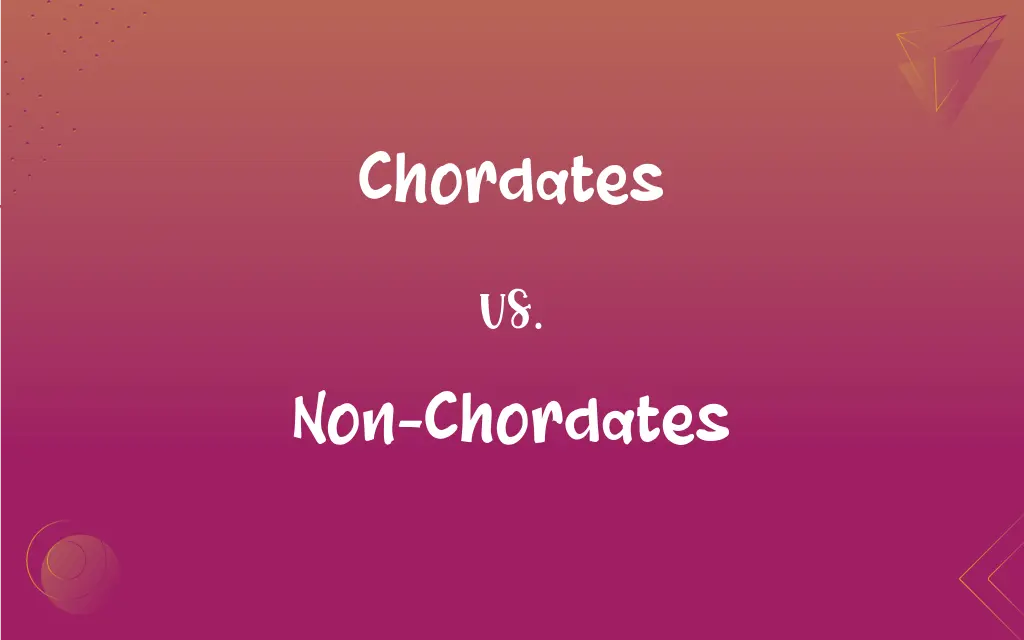Chordates vs. Non-Chordates: What's the Difference?
Edited by Aimie Carlson || By Harlon Moss || Updated on October 28, 2023
Chordates possess a notochord, dorsal nerve cord, pharyngeal slits, and post-anal tail at some life stage, while non-chordates lack these features.

Key Differences
Chordates are a diverse group of animals that, at some point in their development, possess a notochord, which is a flexible rod supporting the body. Non-chordates, in contrast, do not have this structure at any stage of their life.
One of the primary characteristics of chordates is the presence of a dorsal nerve cord, which is positioned above the notochord. Non-chordates, however, do not exhibit this feature, and their nervous systems may differ significantly.
Chordates typically have pharyngeal slits at some stage of their development, which can develop into various structures in adult animals. Non-chordates lack these slits, and their respiratory or feeding structures can be vastly different.
Another distinguishing feature of chordates is the post-anal tail, which is an extension of the body beyond the anal opening. Non-chordates might have tails, but they do not possess the post-anal structure specific to chordates.
In essence, while chordates showcase certain specific anatomical characteristics during their life, non-chordates have a broader range of anatomical diversity, lacking the specific features that define chordates.
ADVERTISEMENT
Comparison Chart
Notochord Presence
Present at some stage of life.
Absent at all stages of life.
Dorsal Nerve Cord
Present, positioned above the notochord.
Absent or different type of nervous system.
Pharyngeal Slits
Present at some stage of life.
Absent.
Post-anal Tail
Present, an extension beyond the anal opening.
Absent or different tail structure.
Anatomical Diversity
Specific features defining the group.
Broader range of anatomical structures.
ADVERTISEMENT
Chordates and Non-Chordates Definitions
Chordates
Chordates are animals that possess a notochord during some phase of their life.
Vertebrates like humans are advanced chordates with a backbone.
Non-Chordates
Non-chordates may have a tail but not the post-anal tail found in chordates.
While some non-chordates like scorpions have tails, they don't possess the post-anal structure of chordates.
Chordates
Chordates are characterized by pharyngeal slits at a certain developmental stage.
In some chordates, like fish, the pharyngeal slits evolve into gills.
Non-Chordates
Non-chordates encompass a wide range of animals outside the phylum Chordata.
The vast diversity of insects, from ants to butterflies, falls under non-chordates.
Chordates
Chordates have a post-anal tail, an extension of the body beyond the anus.
The tail in chordates like lizards is a noticeable post-anal structure.
Non-Chordates
Non-chordates are animals that never possess a notochord during their life cycle.
Insects, as non-chordates, have an exoskeleton but lack a notochord.
Chordates
Chordates have a dorsal nerve cord, distinguishing them from many other animals.
The dorsal nerve cord in chordates like fish becomes the spinal cord.
Non-Chordates
Non-chordates do not exhibit the dorsal nerve cord typical of chordates.
Non-chordates like mollusks have a different nervous system configuration.
Chordates
Chordates belong to the phylum Chordata, a diverse group within the animal kingdom.
Birds, despite their diverse appearances and lifestyles, are chordates due to shared fundamental characteristics.
Non-Chordates
Non-chordates lack pharyngeal slits at any stage of their development.
Non-chordates like spiders respire through book lungs, not pharyngeal slits.
Chordates
Any of numerous animals of the phylum Chordata, having at some stage of development a dorsal nerve cord, a notochord, and gill slits and including all vertebrates, the hagfishes, and certain marine animals such as the lancelets and the tunicates.
Chordates
Plural of chordate
FAQs
What are the defining features of chordates?
Chordates possess a notochord, dorsal nerve cord, pharyngeal slits, and post-anal tail at some life stage.
What's an example of a non-chordate?
An example of a non-chordate is a jellyfish.
Can non-chordates be multicellular organisms?
Yes, many non-chordates are multicellular, like insects, worms, and mollusks.
Do all chordates lay eggs?
No, while many chordates lay eggs, others give birth to live young.
Do all chordates have a backbone?
No, not all chordates have a backbone; for example, tunicates and lancelets.
Do chordates always retain the notochord in their adult stage?
No, in many chordates, the notochord is only present during the embryonic stage and may be replaced by other structures in adults.
Do chordates always have a post-anal tail?
Chordates have a post-anal tail at some life stage, but it may not always be retained in adulthood.
Do non-chordates ever have a notochord?
No, non-chordates never possess a notochord at any stage of their life.
Are all chordates vertebrates?
No, not all chordates are vertebrates; however, all vertebrates are chordates.
Is the notochord the same as a backbone?
No, the notochord is a flexible rod, while the backbone comprises vertebrae and encloses the spinal cord.
Can non-chordates have complex organ systems?
Yes, many non-chordates, like mollusks and arthropods, have complex organ systems.
Are humans considered chordates?
Yes, humans are considered chordates because, during embryonic development, they exhibit characteristics of the group.
Why don't non-chordates have a dorsal nerve cord?
Non-chordates evolved different nervous system configurations and lack the specific dorsal nerve cord characteristic of chordates.
Can chordates be invertebrates?
Yes, some chordates, like tunicates and lancelets, are invertebrates.
What's the significance of pharyngeal slits in chordates?
In chordates, pharyngeal slits can play roles in feeding, breathing, or both, and their function can vary across species.
Which group is more diverse in terms of species: chordates or non-chordates?
Non-chordates are more diverse, encompassing a vast array of species outside the phylum Chordata.
Are chordates exclusively marine animals?
No, chordates can be found in marine, freshwater, and terrestrial environments.
What kind of respiratory structures might non-chordates possess?
Non-chordates might have gills, lungs, tracheae, or other structures, depending on the species.
Do non-chordates belong to a single phylum?
No, non-chordates span multiple phyla, like Arthropoda, Mollusca, Cnidaria, and more.
Which group has a wider variety of body forms, chordates or non-chordates?
Non-chordates exhibit a broader diversity of body forms compared to chordates.
About Author
Written by
Harlon MossHarlon is a seasoned quality moderator and accomplished content writer for Difference Wiki. An alumnus of the prestigious University of California, he earned his degree in Computer Science. Leveraging his academic background, Harlon brings a meticulous and informed perspective to his work, ensuring content accuracy and excellence.
Edited by
Aimie CarlsonAimie Carlson, holding a master's degree in English literature, is a fervent English language enthusiast. She lends her writing talents to Difference Wiki, a prominent website that specializes in comparisons, offering readers insightful analyses that both captivate and inform.































































